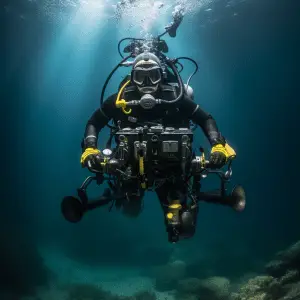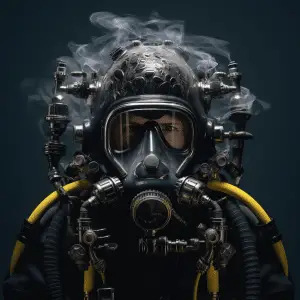Introduction to Rebreathers

Rebreathers are an innovative diving technology that allows divers to explore the depths of the ocean with extra safety and efficiency. They recycle exhaled air, so oxygen levels stay higher and gas consumption is minimized.
We must understand how these ingenious devices work. Inside is a complex system of valves, filters, and sensors that ensure diver safety. Such tech removes carbon dioxide and monitors depth and gas mixture. It also lets divers venture further underwater, reducing environmental impact.
What sets rebreathers apart from traditional scuba diving systems? One big advantage is minimized bubble formation. Unlike other open-circuit scuba tanks that release bubbles, they remain silent. This lets divers witness natural behaviors undisturbed.
Why wait on the shore when extraordinary adventures await beneath the sea? Embrace the world of rebreathers and unlock endless opportunities for exploration. Whether experienced or aspiring, don’t miss out on the chance to experience the hidden treasures.
Unleash your curiosity and embark on unforgettable journeys with this cutting-edge diving technology. With rebreathers, every dive can be an extraordinary escapade into uncharted territories. Let go of constraints imposed by traditional scuba systems and explore a world of limitless possibilities – made possible through rebreathers.
Types of Rebreathers: From budget-friendly models to high-tech ones that may or may not make you Aquaman – who doesn’t want to live out their superhero dreams underwater?
Types of Rebreathers
To understand the types of rebreathers, let’s explore the closed-circuit rebreather. These devices play a vital role in creating a closed breathing loop for divers. Their unique advantages and functionalities make them a preferred choice among underwater explorers. Discover the fascinating world of closed-circuit rebreather and unlock the possibilities they offer.
Closed-Circuit Rebreathers
Closed-Circuit Rebreathers are tech-savvy diving solutions. They offer efficient performance and safety underwater.
Types of Closed-Circuit Rebreathers include:
- Semiautomatic – Automatically controls the flow of gases and maintains oxygen levels. Suitable for recreational and technical divers.
- Manual – Divers must manually adjust the gas mixtures. Experienced divers enjoy customization.
- Electronic – Advanced sensors and algorithms monitor and control gas mixtures automatically. High level of safety and precision.
No bubbles form in a closed system, ideal for delicate eco-systems and military operations.
Dive into a world of exploration and discovery with Closed-Circuit Rebreathers. Take your diving adventures to new depths! Dive and witness breathtaking marine life up close. Embrace the chance to take a deep breath and plunge into the abyss!
Benefits of Rebreathers

To enhance your understanding of the benefits of rebreathers, let’s dive into the section discussing the various advantages they offer. Specifically, we will explore how provide enhanced safety features, ensuring a safer diving experience.
Enhanced Safety Features
Rebreathers, an underwater diving apparatus, come with a host of enhanced safety features which make them an invaluable asset for divers. These features not only ensure safety but also provide peace of mind on underwater adventures.
- Enhanced Air Quality: Rebreathers have the ability to recycle exhaled air. This is done by removing carbon dioxide and replenishing oxygen, which vastly improves the quality of air breathed in by divers. Thus, reducing the chances of respiratory issues and allowing for longer dives.
- Extended Dive Time: Rebreathers allow divers to stay underwater for longer. Through recycling air and decreasing gas consumption, dive time is increased and decompression requirements minimized. This enables dives to deeper depths and more immersive experiences.
- Redundant Safety Systems: Rebreathers are equipped with redundant safety systems for added protection. They include multiple sensors that constantly monitor oxygen levels and water pressure. In the event of a malfunction, these will alert the diver and switch to a backup system, ensuring a safe ascent.
Moreover, Its provide unique details not seen in traditional scuba gear. These include silent operation that reduces disturbance to marine life, enabling divers to observe creatures in their natural habitat.
Additionally, rebreathers are smaller and lighter than scuba gear, allowing for more mobility and flexibility during dives.
Pro Tip: Make sure to get proper training and certification before using a rebreather. Learn its operation and maintenance procedures for safe and enjoyable diving experiences.
Oh, and don’t forget that rebreathers are not just for underwater explorers, but also second-hand garlic bread connoisseurs everywhere!
Applications of Rebreathers
Rebreathers are very useful devices! They have countless practical applications. For example, they enable divers to explore great depths without resurfacing. Also, they are used in military operations that require secrecy and extended underwater activity. Furthermore, rebreather are used for scientific research, helping scientists study marine life without disrupting their environment.
Here are more uses of rebreathers:
| Application | Description |
|---|---|
| Military Operations | Special forces use them for secret ops under the sea. |
| Deep-sea Exploration | Explorers can reach extreme depths for research. |
| Scientific Research | Scientists can observe underwater ecosystems and organisms. |
| Search and Rescue | Rescue divers can operate safely in demanding environments. |
Rebreather technology has grown a lot over time. Nowadays, they are more reliable and efficient due to better materials and designs. This has made underwater activities safer and more accessible.
Believe it or not, rebreather technology dates back to the 1800s! Inventors like Siebe Gorman and Augustus Siebe developed early versions of closed-circuit breathing apparatuses. Since then, divers have driven the evolution of rebreather tech.
